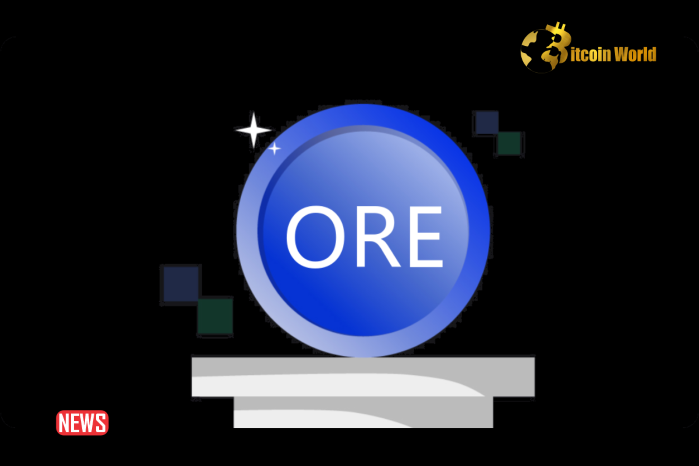In the fast-paced world of blockchain, innovation is the name of the game. And when it comes to the Solana network, known for its speed and efficiency, any protocol making waves deserves a closer look. Enter Ore Protocol, and specifically, its upgraded Version 2 (V2). This isn’t just another update; it’s a significant development that’s currently powering a notable chunk of all transactions on the Solana network. But what exactly is Ore Protocol, and why is V2 causing such a stir? Let’s dive in and explore.
What is Ore Protocol and Why is it on Solana?
Imagine Bitcoin’s mining concept, but reimagined for the high-throughput Solana blockchain. That’s essentially what Ore Protocol is. Think of it as a unique experiment, blending the principles of proof-of-work (PoW) with Solana’s lightning-fast transaction capabilities. But unlike Bitcoin mining which directly validates transactions, Ore takes a slightly different approach.
Originally conceived as a test to see how PoW mechanics could integrate with Solana’s architecture, Ore Protocol doesn’t directly secure the network. Instead, it uses a PoW-like puzzle as an engaging mechanism to distribute tokens – essentially a gamified airdrop. Participants solve these puzzles, simulating mining, and in return, they receive Ore tokens. This innovative approach quickly gained traction, making Ore one of the most talked-about protocols on Solana.
Ore Protocol V2: A Necessary Upgrade for Enhanced Performance
The initial version of Ore Protocol (V1) achieved rapid popularity, perhaps even exceeding expectations. However, this surge in activity inadvertently revealed some weak points in Solana’s infrastructure. The sheer volume of transactions from Ore mining contributed to network congestion, highlighting the need for optimization. Hardhat Chad, the creator of Ore Protocol, recognized these challenges and took proactive steps, pausing mining operations to develop a more robust and efficient V2 contract. This wasn’t a setback, but rather a crucial step towards building a more sustainable and effective protocol.
What Improvements Does V2 Bring?
Ore Protocol V2 is designed to be a significant upgrade over its predecessor, focusing on several key areas:
- Enhanced Efficiency: V2 aims to streamline the mining process, reducing inefficiencies that were present in the original design. This means faster and smoother transactions for miners and less strain on the Solana network.
- Improved Transaction Success Rates: One of the most notable improvements is the drastic increase in transaction success rates. V1 struggled with frequent transaction failures, but V2 boasts a significantly lower failure rate, leading to a much better user experience for miners.
- Incentivizing Token Holding: V2 incorporates mechanisms to encourage miners to hold onto their earned Ore tokens, fostering a stronger and more stable token economy.
- Open Source and Community-Driven: Hardhat Chad has open-sourced the Ore Protocol project, inviting community contributions. This move towards decentralization and collaboration can lead to further innovation and improvements, making Ore Protocol even more resilient and adaptable.
As Hardhat Chad wrote:
The ORE CLI is open-source and includes many public contributions. If you’ve modded your miner and think the community would benefit from your changes, please open a PR and dm/tag me for review.
— Hardhat Chad (@HardhatChad) November 6, 2023
Ore Protocol V2 in Numbers: Making a Real Impact
The impact of Ore Protocol V2 is clearly visible in the data. Let’s look at some key metrics that highlight its performance:
- Significant Transaction Share: According to Top Ledger data, Ore Protocol V2 is responsible for approximately 14% of all transactions on the Solana network. This is a substantial figure, demonstrating the protocol’s widespread adoption and activity.
- Surge in Miner Activity: Since the launch of V2 on August 6th, there has been a remarkable surge in mining activity. Dune Analytics data reveals that over 30,000 Ore miners became active within just two days of the V2 launch.
- Fees Paid by Miners: This increased activity translates to real economic impact. These 30,000+ miners collectively paid around 1,498 SOL in fees in just under two days. At current prices, this is equivalent to approximately $230,000, showcasing the significant economic activity generated by Ore Protocol V2.
- Dramatically Improved Success Rates: Top Ledger highlights the stark contrast between V1 and V2 in terms of transaction success. V1 suffered from frequent failures, while V2 has achieved a failure rate of less than 5%. This improvement underscores the enhanced efficiency and user experience provided by the V2 upgrade.
Transaction Success Rate Comparison
| Feature | Ore Protocol V1 | Ore Protocol V2 |
|---|---|---|
| Transaction Success Rate | Low (Frequent Failures) | High (Less than 5% Failure Rate) |
| Efficiency | Lower | Higher |
| User Experience | Less Smooth | Smoother, More Reliable |
What Does the Future Hold for Ore Protocol?
Currently, the price of ORE token is around $185.62, with over 14,000 tokens already mined. The protocol estimates that the total supply of 21 million ORE tokens will be fully mined by the year 2064. This long-term mining schedule suggests a sustained level of activity and engagement within the Ore Protocol ecosystem for decades to come.
Ore Protocol V2 is not just a simple upgrade; it represents a significant step forward in the evolution of blockchain protocols on Solana. By addressing the challenges of V1 and introducing key improvements in efficiency, reliability, and community involvement, V2 is solidifying Ore Protocol’s position as a major contributor to the Solana network. Its innovative approach to token distribution and its impact on transaction volume demonstrate the potential for creative and engaging protocols to thrive within the Solana ecosystem. As Ore Protocol continues to evolve, it will be fascinating to watch its ongoing impact on Solana and the broader crypto landscape.
Disclaimer: The information provided is not trading advice, Bitcoinworld.co.in holds no liability for any investments made based on the information provided on this page. We strongly recommend independent research and/or consultation with a qualified professional before making any investment decisions.



